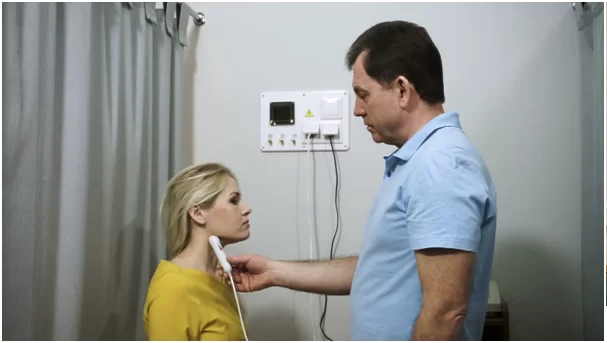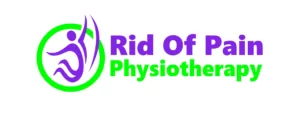Electrotherapy
Electrotherapy Treatment is the use of electrical energy as a medical treatment. Electrotherapy can apply to a variety of treatments, including the use of electrical devices such as deep brain stimulators for neurological diseases.

Medical Uses of Electrotherapy Treatment
- Relaxation of muscle spasm
- Prevention and retardation of disuse atrophy
- Increase in local blood circulation
- Acute post-traumatic and post-surgical pain
- Maintaining and increasing range of motion
- Wound healing
Therapeutic Modalities used at Rid of Pain Physiotherapy
- Transcutaneous Electrical Nerve Stimulation (TENS)
- Interferential Therapy (IFT)
- Ultrasound
- Low-Level Laser Therapy
- Lumber Mechanical Traction
- Cryotherapy
- High Power Laser Therapy
Transcutaneous Electrical Nerve Stimulation (TENS)
TENS is a method of electrical stimulation that primarily aims to provide a degree of symptomatic pain relief by exciting sensory nerves and thereby stimulating either the pain gate mechanism and/or opioid system.
Mechanism of action
The type of stimulation delivered by the TENS unit aims to stimulate the sensory nerves, and by so doing, activate specific natural pain relief pain mechanisms.
Pain relief using the pain gate mechanism involves activation (excitation) of the A beta (Aβ) sensory fibers, and by doing so, reduces the transmission of the noxious stimulus from the ‘c’ fibers, through the spinal cord and hence onto the higher centers. The Aβ fibers appear to appreciate being stimulated at a relatively high-frequency HF (in the order of 90 – 130 Hz or PPS).
Electrode Placement Technique
This is determined by the target muscle or muscle group either single or about other muscles.
- Unilateral: Unilateral placement causes inflammation of one limb or half of the muscle pain.
- Bilateral: It allows the stimulation of both limbs or both halves of a muscle Pair
- Uni-polar: Only one of two essential leads and the electrode connected to it are placed over the target area affected by the stimulation. This electrode is called a treatment electrode.
- Quadripolar: Involve the use of two sets of electrodes each originating from its channel. It may be considered the concurrent application of two bi-polar circuits. This technique could be used with the stimulation of agonists and antagonists. Also could be used in crossed patterns or for large flat areas as back.
Intensity
A dial allows the user to adjust the intensity of the electrical stimulation.
Frequency
The frequency refers to the number of electrical pulses per second. High-frequency (HF) pulses range from 80 to 120 cycles per second and may help manage acute pain. Low-frequency (LF) pulses range from 1 to 20 cycles per second and are suitable for the treatment of chronic pain.
Duration
The duration is the number of microseconds that the current enters the skin during each pulse.
TENS units may help treat the following symptoms:
- Period pain
- Labour pain
- Postoperative pain
- Joint pain
- Neck and back pain
They may also alleviate the pain that results from the following conditions:
- Arthritis
- Sports injuries
- Multiple sclerosis
- Fibromyalgia
- Painful diabetic neuropathy
- Spinal cord injury
Interferential Therapy (IFT)
The basic principle of Interferential Therapy (IFT) is to utilize the strong physiologicaportable effects of low frequency (<250pps) electrical stimulation of nerves without the associated painful and somewhat unpleasant side effects sometimes associated with low-frequency stim.
Benefits of IFT Physiotherapy
IFT Physiotherapy uses are extremely in;
- increasing blood circulation
- reducing pain, and inflammation
- vasodilation
- curing edema and hematoma
- removing waste substances from the affected area
- increasing muscle stimulation
- Increasing metabolic rate
- decreasing blood pressure
- treating chronic ligamentous lesions
- improving restricted movements of joints
- restoring the lost movement of muscles
Physiotherapy Electrotherapy Treatments
Ultrasound Therapy
A common misconception about physiotherapy treatments is that they are limited to massage techniques and exercise prescriptions. This is of course not true, as the modern methods that our physiotherapy team uses utilize technology to a great extent. One such method that may be used, is Ultrasound therapy. Physio Una explains how this technique is employed by our physiotherapists and answers some of the more frequently asked questions about the therapy.
More about Ultrasound Therapy
Ultrasound therapy is electrotherapy that has been used in physiotherapy practices for many years. It is mainly used for its non-thermal effect where high-frequency sound waves cause vibrations and movement of cellular fluids.
The proposed benefits of ultrasound therapy include improving the healing rate of certain soft tissues.
It is hypothesized to:
- Increase blood flow to an area to accelerate the resolution time of the inflammatory process.
- Stimulate the production of collagen (the main protein in tendons and ligaments) during tissue healing.
Frequency
The number of times a particle experiences a complete compression/rarefaction cycle in 1 second. Typically 1 or 3 MHz.
Injuries Treated With Ultrasound
Low-Level Laser Therapy
It is used by some physiotherapists to treat various musculoskeletal conditions. LLLT is a non-invasive light source treatment that generates a single wavelength of light. It emits no heat, sound, or vibration. It is also called photobiology or biostimulation. LLLT is believed to affect the function of connective tissue cells (fibroblasts), accelerate connective tissue repair, and act as an anti-inflammatory agent.
Effects of LLLT
The effects of the LLLT which are significant for physiotherapy, and make this tool useful to enhance other treatments such as therapeutic exercise, are:
- Reduction of inflammation: It can occur within hours to days.
- Pain relief
- Accelerated tissue regeneration: LLLT stimulates cell proliferation of fibroblasts, keratinocytes, endothelial cells, and lymphocytes.
In physiotherapy, LLLT is used for pain relief, accelerated tissue regeneration, and reduction of inflammation.
Conditions that are treated include
- Osteoarthritis of the knee, hip and ankle
- Rheumatoid arthritis
- TMJ
- Shoulder impingement syndromes
- Hip or shoulder bursitis
- Low back disc degeneration
- Disc herniation
- Sciatica
- Neuropathic pain
- Tendonitis
- Tennis elbow
- Plantar fasciitis
- Reduction of volume and pain in lymphedema
Traction Therapy
Traction is a manual technique designed to reduce pressure on affected vertebral discs that are causing pain. Traction is a manual ‘stretching’ of the spine that reduces pressure on the discs and therefore reduces the individual’s pain.
Manual Traction
In manual spinal traction, a physical therapist uses their hands to put people in a state of traction. Then they use manual force on the joints and muscles to widen the spaces between vertebrae. The period of traction generally doesn’t last very long. Manual traction sounds quite scary however it is a safe treatment option that can be effective for certain conditions.
Mechanical Traction
The specialized treatment technique of mechanical traction uses devices that work by stretching the spinal vertebrae and muscle. Mechanical traction allows for continuous or intermittent stretching on a traction table while combining heat, vibration, and/or massage. These tables can use computer-based systems to apply exact amounts and/or variations of pressure. Mechanical traction is, however, not appropriate for patients with serious bone conditions such as osteoporosis, osteomyelitis, and bone cancer, or with heart disease and spinal cord diseases. It is also not appropriate for those with spinal fractures or arthritis. This type of treatment should only be considered following careful examination and diagnosis, and professionally supervised by a licensed physical therapist or doctor to ensure effectiveness and safety.
Traction is a technique used to stretch soft tissues and separate joint surfaces or bone fragments using a pulling force. The force applied must be of sufficient magnitude and duration in the proper direction while resisting movement of the body with an equal and opposite force. People with specific spinal conditions benefit from this therapy and is most commonly used to treat:
Uses
- Slipped discs
- Bone spurs
- Degenerative disc disease
- Herniated discs
- Facet disease
- Sciatica
- Foramina stenosis
- Pinched nerves
- Cervical Spondylosis
- Lumbar Spondylosis
Cryotherapy
Cryotherapy, also known as ice application, is the simplest and oldest way to treat injuries. Its worldwide use spread because of its effectiveness, convenience, low cost, and ease of transportation. Ice is believed to control pain by instigating local anesthesia. It also decreases edema, nerve conduction velocities, cellular metabolism, and local blood flow. The effect of cryotherapy depends on the method, the duration, the temperature of the ice, and the depth of the subcutaneous fat.
Application Methods
Ice pack being used for calf strain.
- Ice Packs: It is the most common method of cryotherapy. There are different types of ice used in ice packs. The most common types are ice packs made with cubed, crushed, and wetted ice. It was discovered that wetted ice is better to lower surface temperature during treatment and maintain the lower temperature during recovery. It is also more effective in lowering the intramuscular temperature during treatment.
- Ice Spray: A cooling effect can also be produced by icing spray for a similar effect.
- Immersion: Simple or whirlpool immersion.
- Ice Massage: slow strokes in a circular motion for 5-10 mins.
More recently whole body cryotherapy has become popular for athletes, to help aid recovery, as well as in persistent pain patients with rheumatological conditions. More research is needed to understand the effect on the body and its relation to pain.
Conditions Treated
- Acute soft tissue injuries e.g. ankle sprain, muscular sprain, ligament sprain
- Myofascial trigger points
- Tendinitis
- Acute swelling
- Bursitis
- Post orthopaedic surgery e.g. TKR, ACL reconstruction, Arthroscopic Shoulder Surgery.
- Acute sports injuries
- DOMS
High Power Laser Therapy
LASER means Light Amplification from Stimulated Emission of Radiation. A laser is created by a specific process within the laser device to cause the controlled emission of radiation in the form of light. Lasers were first invented by physicist Gordon Gould in 1958 and the first working model was built in 1960. They have been used in Europe and America for more than forty years and have been used in the fields of dermatology, and surgery. Ophthalmology and physical medicine and rehabilitation. Laser is used by physiotherapists for the relief of pain, to accelerate healing, and to decrease inflammation.
Properties of Laser
Due to the specific nature of how the laser is produced it also has specific properties;
- Monochromatic – Monochromaticity refers to the color or wavelength of light. Since the laser is produced from a single active medium laser light it is of a single color, one wavelength.
- Coherent and Parallel- Due to the common wavelength of laser light, the phase of each wave is also common. Light travels in sine waves in-phase relationship with one another with peaks and valleys precisely coinciding and reinforcing each other so laser light travels as a parallel beam spreading very little.
Keywords
Musculoskeletal pain, Laser therapy, Rehabilitation, Intervention.
USES
Laser therapy (high-intensity laser therapy) can treat a variety of conditions, such as:
- Osteoarthritis of the knee, hip and ankle
- Rheumatoid arthritis
- Shoulder impingement syndromes
- Hip or shoulder bursitis
- Low back disc degeneration
- Disc herniation
- Sciatica
- Tendonitis
- Tennis elbow
- Plantar fasciitis
